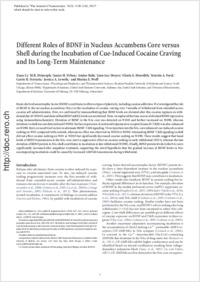Different Roles of BDNF in Nucleus Accumbens Core versus Shell during the Incubation of Cue-Induced Cocaine Craving and Its Long-Term Maintenance
- Li, Xuan Departments of Neuroscience, Rosalind Franklin University of Medicine and Science, North Chicago, USA
- DeJoseph, M.R. Physiology and Biophysics, Rosalind Franklin University of Medicine and Science, North Chicago, USA
- Urban, Janice H. Physiology and Biophysics, Rosalind Franklin University of Medicine and Science, North Chicago, USA
- Bahi, Amine Department of Anatomy, United Arab Emirates University, Alabama-Ain, United Arab Emirates
- Dreyer, Jean-Luc Division of Biochemistry, Department of Medicine, University of Fribourg, Switzerland
- Meredith, Gloria E. Pharmaceutical Sciences, Rosalind Franklin University of Medicine and Science, North Chicago, USA
- Ford, Kerstin A. Departments of Neuroscience, Rosalind Franklin University of Medicine and Science, North Chicago, USA
- Ferrario, Carrie R. Departments of Neuroscience, Rosalind Franklin University of Medicine and Science, North Chicago, USA
- Loweth, Jessica A. Departments of Neuroscience, Rosalind Franklin University of Medicine and Science, North Chicago, USA
- Wolf, Marina E. Departments of Neuroscience, Rosalind Franklin University of Medicine and Science, North Chicago, USA
-
19.11.2012
Published in:
- The Journal of Neuroscience. - 2013, vol. 33, no. 3, p. 1130-1142
English
Brain-derived neurotrophic factor (BDNF) contributes to diverse types of plasticity, including cocaine addiction. We investigated the role of BDNF in the rat nucleus accumbens (NAc) in the incubation of cocaine craving over 3 months of withdrawal from extended access cocaine self-administration. First, we confirmed by immunoblotting that BDNF levels are elevated after this cocaine regimen on withdrawal day 45 (WD45) and showed that BDNF mRNA levels are not altered. Next, we explored the time course of elevated BDNF expression using immunohistochemistry. Elevation of BDNF in the NAc core was detected on WD45 and further increased on WD90, whereas elevation in shell was not detected until WD90. Surface expression of activated tropomyosin receptor kinase B (TrkB) was also enhanced on WD90. Next, we used viral vectors to attenuate BDNF-TrkB signaling. Virus injection into the NAc core enhanced cue-induced cocaine seeking on WD1 compared with controls, whereas no effect was observed on WD30 or WD90. Attenuating BDNF-TrkB signaling in shell did not affect cocaine seeking on WD1 or WD45 but significantly decreased cocaine seeking on WD90. These results suggest that basal levels of BDNF transmission in the NAc core exert a suppressive effect on cocaine seeking in early withdrawal (WD1), whereas the late elevation of BDNF protein in NAc shell contributes to incubation in late withdrawal (WD90). Finally, BDNF protein levels in the NAc were significantly increased after ampakine treatment, supporting the novel hypothesis that the gradual increase of BDNF levels in NAc accompanying incubation could be caused by increased AMPAR transmission during withdrawal.
- Faculty
- Faculté des sciences et de médecine
- Department
- Département de Médecine
- Language
-
- English
- Classification
- Biological sciences
- Other electronic version
- License
-
License undefined
- Identifiers
-
- RERO DOC 31825
- Persistent URL
- https://folia.unifr.ch/unifr/documents/302818
Statistics
Document views: 87
File downloads:
- pdf: 248
